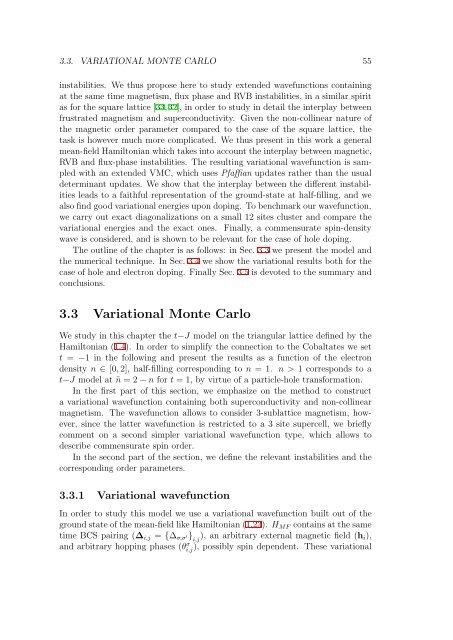pdf, 9 MiB - Infoscience - EPFL
pdf, 9 MiB - Infoscience - EPFL
pdf, 9 MiB - Infoscience - EPFL
Create successful ePaper yourself
Turn your PDF publications into a flip-book with our unique Google optimized e-Paper software.
3.3. VARIATIONAL MONTE CARLO 55<br />
instabilities. We thus propose here to study extended wavefunctions containing<br />
at the same time magnetism, flux phase and RVB instabilities, in a similar spirit<br />
as for the square lattice [33,32], in order to study in detail the interplay between<br />
frustrated magnetism and superconductivity. Given the non-collinear nature of<br />
the magnetic order parameter compared to the case of the square lattice, the<br />
task is however much more complicated. We thus present in this work a general<br />
mean-field Hamiltonian which takes into account the interplay between magnetic,<br />
RVB and flux-phase instabilities. The resulting variational wavefunction is sampled<br />
with an extended VMC, which uses Pfaffian updates rather than the usual<br />
determinant updates. We show that the interplay between the different instabilities<br />
leads to a faithful representation of the ground-state at half-filling, and we<br />
also find good variational energies upon doping. To benchmark our wavefunction,<br />
we carry out exact diagonalizations on a small 12 sites cluster and compare the<br />
variational energies and the exact ones. Finally, a commensurate spin-density<br />
wave is considered, and is shown to be relevant for the case of hole doping.<br />
The outline of the chapter is as follows: in Sec. 3.3 we present the model and<br />
the numerical technique. In Sec. 3.4 we show the variational results both for the<br />
case of hole and electron doping. Finally Sec. 3.5 is devoted to the summary and<br />
conclusions.<br />
3.3 Variational Monte Carlo<br />
We study in this chapter the t−J model on the triangular lattice defined by the<br />
Hamiltonian (1.4). In order to simplify the connection to the Cobaltates we set<br />
t = −1 in the following and present the results as a function of the electron<br />
density n ∈ [0, 2], half-filling corresponding to n =1. n>1 corresponds to a<br />
t−J model at ñ =2− n for t = 1, by virtue of a particle-hole transformation.<br />
In the first part of this section, we emphasize on the method to construct<br />
a variational wavefunction containing both superconductivity and non-collinear<br />
magnetism. The wavefunction allows to consider 3-sublattice magnetism, however,sincethelatterwavefunctionisrestrictedtoa3sitesupercell,webriefly<br />
comment on a second simpler variational wavefunction type, which allows to<br />
describe commensurate spin order.<br />
In the second part of the section, we define the relevant instabilities and the<br />
corresponding order parameters.<br />
3.3.1 Variational wavefunction<br />
In order to study this model we use a variational wavefunction built out of the<br />
ground state of the mean-field like Hamiltonian (1.23). H MF contains at the same<br />
time BCS pairing (∆ i,j = {∆ σ,σ ′} i,j<br />
), an arbitrary external magnetic field (h i ),<br />
and arbitrary hopping phases (θi,j σ ), possibly spin dependent. These variational
















